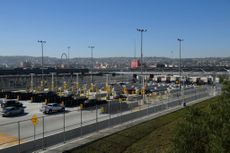The women of Greenham Common and their legacy 40 years on
How did a peace camp first established in Berkshire in 1981 become the largest women’s protest since the suffragettes?

In 1981, four friends from west Wales – Ann Pettitt, Karmen Cutler, Lynne Whittemore and Liney Seward – decided to walk 120 miles to RAF Greenham Common in Berkshire to protest at the storing of US nuclear cruise missiles on British soil.
On 27 August, 36 women, four men and a handful of children left Cardiff. Ten days later, the marchers reached the base and delivered an open letter to the commander, stating: “We are implacably opposed to the siting of US cruise missiles in this country.” To reinforce the point, 36 of the marchers chained themselves to the base fence, in a deliberate echo of the suffragettes.
Why were US missiles in Berkshire?
Subscribe to The Week
Escape your echo chamber. Get the facts behind the news, plus analysis from multiple perspectives.

Sign up for The Week's Free Newsletters
From our morning news briefing to a weekly Good News Newsletter, get the best of The Week delivered directly to your inbox.
From our morning news briefing to a weekly Good News Newsletter, get the best of The Week delivered directly to your inbox.
In the late 1970s, the Soviet Union deployed a new intermediate-range missile, the SS-20 – which, in theory, had the ability to destroy all Nato bases in Europe. This alarmed military planners in Britain and Western Europe.
Nato responded by negotiating for restrictions on such weapons while expanding its own arsenal. In 1979, it decided to deploy US medium-range Pershing II missiles in West Germany, and Tomahawk cruise missiles across Europe. From 1983, 96 of the latter were to be based at Greenham, about four miles from Newbury, where a base built on common land during WWII had been lent to the US air force.
In this period, Cold War tensions, and widespread disquiet about the presence of nuclear weapons in Britain, reached their highest levels since the 1960s.
Why did the Greenham protest continue?
One of the women who chained herself to the fence, Helen John, was so infuriated by the dismissive response of the US commander, who told her she could stay there as long as she liked, that she decided to “take him up on that generous offer”.
Generally, though, the protesters realised that the march alone wasn’t going to provoke a national debate about the missiles. Maintaining a presence became the point. With winter approaching, their improvised bivouacs near the base’s main gate evolved into a permanent “Peace Camp”, which put itself on a women-only footing in February 1982 (men were allowed in during the daytime).
In time, different camps with different cultures sprang up at each of the base’s nine gates. The original camp was “Yellow Gate”. “Green Gate”, the furthest from the road, was considered the most child-friendly. Others had religious, artistic or New Age emphases.
Why women-only?
The original march was conceived as a women’s enterprise, but didn’t exclude men. The decision to have no men was partly practical: they were thought more likely to be violent during protests. It was also partly symbolic: the protesters presented themselves as mothers or grandmothers, protesting in the name of their children and future generations.
The leaderless movement that emerged understood the power of imagery. Some Greenham women styled themselves after witches; they sang and performed “mass ululation”. In 1983, some invaded the base while dressed as teddy bears. Photos of women blocking the gates or being manhandled by police officers filled the newspapers.
The idea of the Peace Camp as a radical space for women acquired its own momentum. “Many of us came for the nuclear weapons and stayed for the feminism,” one participant later said.
Did they spark a debate?
Yes. By the time the first missiles reached Greenham, in November 1983, the camp was internationally famous. Alerted by pre-digital networking methods, such as chain letters and “telephone trees”, 30,000 women turned up in December 1982 for an event called “Embrace the Base”, during which they formed a human chain along all nine miles of the perimeter.
On New Year’s Day in 1983, protesters scaled the fence and danced on the missile silos. In April of the same year, CND staged a 14-mile human chain from Greenham to a weapons factory in Burghfield. Julie Christie, Yoko Ono and Takako Doi, the future leader of the Japanese Social Democrats, visited the site.
The missile deployment – nodded through by James Callaghan’s Labour government in the 1970s, and strongly supported by Margaret Thatcher’s Conservatives – was feverishly discussed in the national media.
How did the authorities react?
The civil and military authorities struggled to find a balance between respecting the right to protest and keeping the base running, especially after the missiles had been delivered. Newbury District Council regularly sent in bailiffs and bulldozers. There were mass arrests under hastily enacted by-laws, which were found to be illegal by the House of Lords in 1990.
The camps came under attack from right-wing vigilantes, some of them organised into groups such as RAGE (Ratepayers Against the Greenham Encampments), and the conservative press portrayed the women as crazed, unwashed lesbian separatists.
Michael Heseltine, then defence secretary, told Parliament in 1983 that intruders ran the risk of being shot. None were. One protester, Helen Thomas, was killed by a police van in 1989, aged 22. Her death was ruled an accident at the inquest.
How did the protest end?
The breakthrough came with the Reykjavik nuclear summit of 1986; as a result, the US air force began to remove the missiles in 1989, completing the job two years later. The base was handed back to the RAF in September 1992, and then closed. In 1997, the Common was redesignated as public parkland; it became common land again.
The last protesters left their camp in September 2000, 19 years after they had arrived. Some had been there for the duration. A business park now covers some of the former airbase. The Cold War-era control tower is a visitor centre. A “Peace Garden” marks the site of Yellow Gate.

The legacy of Greenham
US cruise missiles were removed from Greenham as a result of the Reykjavik Summit, held in 1986 between Ronald Reagan and Mikhail Gorbachev, who had become General Secretary of the USSR a year earlier. Gorbachev unexpectedly agreed to a US “zero option” proposal to eliminate all intermediate-range missiles. The result was the Intermediate-Range Nuclear Forces (INF) Treaty of 1987; Soviet weapons inspectors were admitted to Greenham in 1988.
There are some who argue that Margaret Thatcher, who helped broker the summit, actually did more to lift the nuclear threat than the peace protesters did. However, Gorbachev later specifically said that the Greenham women influenced his decision to go to Reykjavik, and one of Reagan’s advisers later said that the “zero option” had been copied “straight off the women’s banners”.
Their battle against nuclear weapons continues: the Government is going ahead with Trident renewal, and the US, under Donald Trump, withdrew from the INF treaty. However, the peace camp also served as a kind of university for large numbers of politically-minded women who lived there or visited. “The women of Greenham Common taught a generation how to protest,” said the film-maker Beeban Kidron.
Create an account with the same email registered to your subscription to unlock access.
Sign up for Today's Best Articles in your inbox
A free daily email with the biggest news stories of the day – and the best features from TheWeek.com
-
 'Make legal immigration a more plausible option'
'Make legal immigration a more plausible option'Instant Opinion Opinion, comment and editorials of the day
By Harold Maass, The Week US Published
-
 LA-to-Las Vegas high-speed rail line breaks ground
LA-to-Las Vegas high-speed rail line breaks groundSpeed Read The railway will be ready as soon as 2028
By Peter Weber, The Week US Published
-
 Israel's military intelligence chief resigns
Israel's military intelligence chief resignsSpeed Read Maj. Gen. Aharon Haliva is the first leader to quit for failing to prevent the Hamas attack in October
By Justin Klawans, The Week US Published
-
 Artworks stolen by Nazis returned to heirs of cabaret performer
Artworks stolen by Nazis returned to heirs of cabaret performerIt wasn't all bad Good news stories from the past seven days
By The Week Staff Published
-
 Woman reunited with egg she signed in 1951
Woman reunited with egg she signed in 1951It Wasn't All Bad Good news stories from the past seven days
By The Week Staff Published
-
 American rescued after 12 days in Turkish cave
American rescued after 12 days in Turkish caveIt wasn't all bad Good news stories from the past seven days
By The Week Staff Published
-
 Ukrainian military has ‘shown how the Russian army can be beaten’
Ukrainian military has ‘shown how the Russian army can be beaten’Talking Point Recent Ukrainian frontline advances may offer hope for its counter-offensive
By The Week Staff Published
-
 Earring lost at sea returned to fisherman after 23 years
Earring lost at sea returned to fisherman after 23 yearsfeature Good news stories from the past seven days
By The Week Staff Published
-
 Bully XL dogs: should they be banned?
Bully XL dogs: should they be banned?Talking Point Goverment under pressure to prohibit breed blamed for series of fatal attacks
By The Week Staff Last updated
-
 Netanyahu’s reforms: an existential threat to Israel?
Netanyahu’s reforms: an existential threat to Israel?feature The nation is divided over controversial move depriving Israel’s supreme court of the right to override government decisions
By The Week Staff Published
-
 Farmer plants 1.2m sunflowers as present for his wife
Farmer plants 1.2m sunflowers as present for his wifefeature Good news stories from the past seven days
By The Week Staff Published

